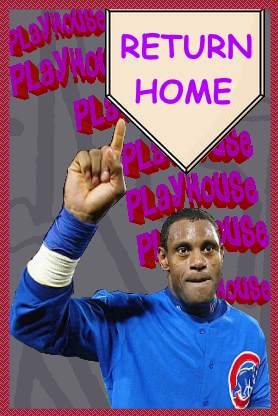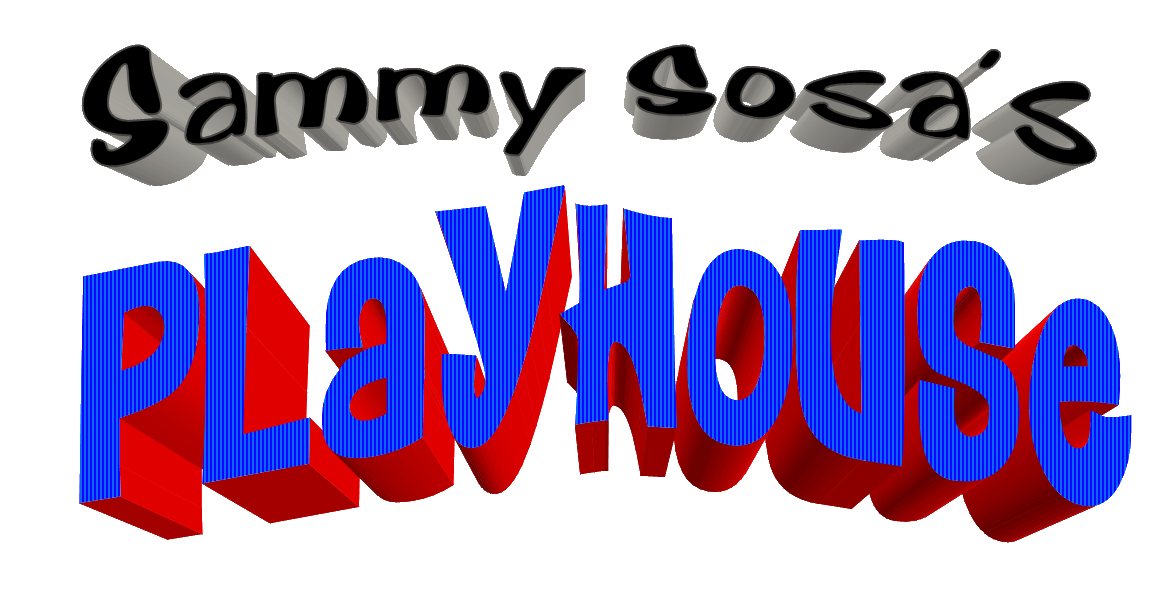
The New Old Look in St. Louis
Written by Paul Hauss and The Fascionista- May 4, 2019
Yesterday's
Cubs-Cardinals game surely
pleased the politically
post-geographic North Side
thanks to Javy Baez's
heroics leading the Cubs to
victory over their historic
rival, but the game caught
the interest of The
Playhouse in another
fashion. The Cardinals have
started to wear throwback
powder blue uniforms during
every Saturday road game in
the 2019 season, and the
redbirds' baby blue bout
with the baby bears
yesterday marked the first
time St. Louis did this
against a Sammy Sosa
Universe team, therefore it
was the first time The
Playhouse was allowed to
notice it. #Saturday
The powder blue uniforms that were ubiquitous in the 1970s and 80s differ from the modern colored tops worn as alternate jerseys for most teams. Those derogatorily-nicknamed softball jerseys are indeed nothing more than jerseys; the pants of these uniforms remain white at home and gray on the road, and the jerseys presently consist only of official team colors. While many Major League teams wear some shade of blue and the teams who wore powder blue were in fact Major League teams, the presence of powder blue is not meant to represent any team color; the non-team blue coated both the jersey and pants. Powder blue was no more of a team color for the team wearing it than white or gray are; the blue was merely a canvas for the team wordmarks and logos. These uniforms were only worn on the road, as they were meant to be a visual alternative to every team using gray as their road canvas. #IGuessThatsWhyTheyWearTheBlues
Almost every team experimented with powder blue road uniforms at some point during the Cocaine Era, regardless of if the team was ever associated with any shade of blue. The Cubs got particularly creative with their take on this spin by adding white pinstripes to their uniforms, as modeled by the cursed image of eventual Boston Bomber accomplice and human Muppet, Bill Buckner. #Goat #TheLowercaseLetteringIsIntentional

The Philadelphia Phillies turned back the clock with powder blue alternates last season, and while their uniforms are nigh identical to their pullovers of baseball past, the Phillies have committed historical revisionism by wearing these throwbacks at home. The Playhouse refuses to acknowledge the Phillies as any part of this fashion revival movement until they correct this willful error. However, we commend the Cardinals for respecting history and wearing their powder blues exclusively as road accessories. We commend the Cardinals. We commend the Cardinals. While that statement is so uncomfortable to publicize that we won't deny having had any strokes, The Gateway City has the #BestPantsInBaseball.
The Playhouse is all for embracing alternatives to standard baseball uniforms, but we have to wonder why Major League Baseball is open to revisiting the Cocaine Era while keeping its back turned on the Steroid Era. Sure, our friends at Andre Dawson's Funeral Home are probably as ecstatic as they are hypersensitive to touch, sound, and sight, but aren't we past 80s nostalgia as society and towards 90s nostalgia? Thanks to Sammy Sosa Jr., The Playhouse now knows what trap music is, so we feel qualified enough to infer that the Kids These Days favor to be subjected to the nostalgia of more dysfunctional and "Generation X"y tastemakers, as opposed to the bright, pastel aesthetic represented in the Reagan White House reenactment festival that is Busch Stadium. # A E S T H E T I C
While the Cocaine Era of baseball broke cultural barriers by accommodating Amish crowd and replacing buttoned jerseys with pullovers, the vastly superior Steroid Era gave us vests. Vests! Any team could have a vest. You have a jersey? Cut the sleeves off and wear a colored undershirt, and boom, you have an alternate. Vests gave us visual variety, because even though Major League Baseball features a vast array of primary color options for their teams, ranging from royal blue to navy blue, it is easy to forget how team colors differ when every home team wears white and every road team wears gray. With vests, spectators are constantly reminded what a team's primary color is. Vests allow large-muscled players to accentuate their 21 inch pythons, brother. Vests give the less athletic participants in the league less ability to hide their high body fat, which renders them more relatable and sympathetic to the average fan. Major League Baseball also has a problematically severe lack of body positivity. The likes of Bartolo Colon and Trevor Cahill should not have to pretend they are physically fit. The psychological damage inflicted on Bartolo by forcing him to conform to normative beauty standards stresses him to the point that he often forgets to pay child support. #VestsForBodyPositivity
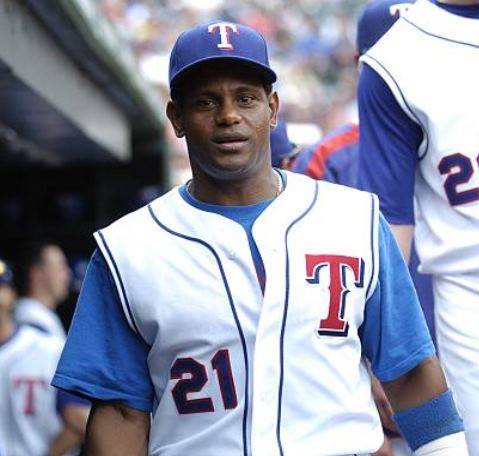
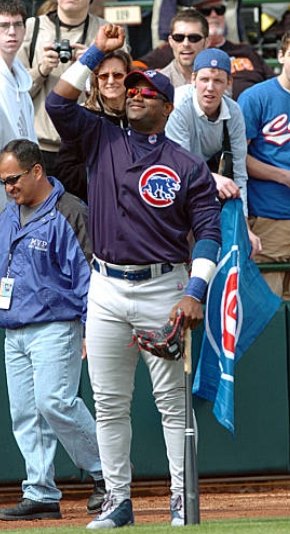
The other defining uniform trend of the Steroid Era was Black For Black's Sake (BFBS), in which teams for whom black is not and has never been an official team color, introduced black jerseys for — as per authoritarian white uniform supremacist doctrine — black's sake. The Chicago White Sox, during Sammy Sosa's tenure with them, were the first team of the 90s to introduce new black jerseys, but they are not considered a true BFBS example because they switched their official team colors from blue and red, to black, white, and silver. BFBS refers to teams like the Mets (modeled in this collection by ideal lead-off man Rey Ordonez standing next to Sammy), Royals, Athletics, and Bluack Jays, who started wearing black seemingly for black's sake. Even the sunny young Cubbies got in touch with the disturbed darkness of their adolescence by briefly experimenting with spring training and batting practice jerseys colored in an after-living midnight blue, immortalized by Sammy's perfect insanity.The Playhouse has a positive view of this uniform trend and does not consider the addition of black to any of these teams' wardrobes arbitrary. Most purists who shame the idea of BFBS tend to support the Cocaine Era's strategy of using powder blue as canvas for team colors, and The Playhouse sees black as a perfectly valid canvas for teams who do not have black as an official team color. #BackInBlack
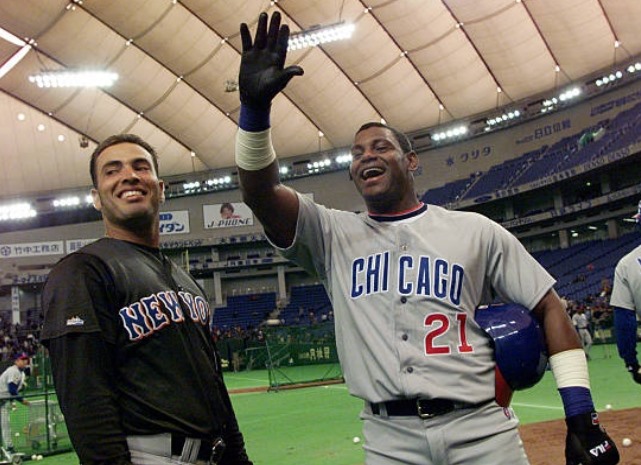
The Playhouse does not enjoy playing the race card, but as a journalistic outlet dedicated to the sports world's only Person of Multiple Colors (PoMC), we consider it an obligation to assess the racial biases held by our colleges in baseball journalism. Why do 80s nostalgists accept powder blue as an alternate canvas, while insisting that black can only be used in a uniform if it is an official team color? Do they take issue with the notion that a Royal could be black? Do they wish to segregate blacks from their Metropolitans? We will allow offer out ideological opponents a platform to elaborate, but until Paul Lukas and Chris Creamer can tell us why this double standard exists for black uniforms, we need to point out the historical dangers of situations in which double standards were applied towards members of the black community. #BlackJerseysMatter
The powder blue uniforms that were ubiquitous in the 1970s and 80s differ from the modern colored tops worn as alternate jerseys for most teams. Those derogatorily-nicknamed softball jerseys are indeed nothing more than jerseys; the pants of these uniforms remain white at home and gray on the road, and the jerseys presently consist only of official team colors. While many Major League teams wear some shade of blue and the teams who wore powder blue were in fact Major League teams, the presence of powder blue is not meant to represent any team color; the non-team blue coated both the jersey and pants. Powder blue was no more of a team color for the team wearing it than white or gray are; the blue was merely a canvas for the team wordmarks and logos. These uniforms were only worn on the road, as they were meant to be a visual alternative to every team using gray as their road canvas. #IGuessThatsWhyTheyWearTheBlues
Almost every team experimented with powder blue road uniforms at some point during the Cocaine Era, regardless of if the team was ever associated with any shade of blue. The Cubs got particularly creative with their take on this spin by adding white pinstripes to their uniforms, as modeled by the cursed image of eventual Boston Bomber accomplice and human Muppet, Bill Buckner. #Goat #TheLowercaseLetteringIsIntentional

The Philadelphia Phillies turned back the clock with powder blue alternates last season, and while their uniforms are nigh identical to their pullovers of baseball past, the Phillies have committed historical revisionism by wearing these throwbacks at home. The Playhouse refuses to acknowledge the Phillies as any part of this fashion revival movement until they correct this willful error. However, we commend the Cardinals for respecting history and wearing their powder blues exclusively as road accessories. We commend the Cardinals. We commend the Cardinals. While that statement is so uncomfortable to publicize that we won't deny having had any strokes, The Gateway City has the #BestPantsInBaseball.
The Playhouse is all for embracing alternatives to standard baseball uniforms, but we have to wonder why Major League Baseball is open to revisiting the Cocaine Era while keeping its back turned on the Steroid Era. Sure, our friends at Andre Dawson's Funeral Home are probably as ecstatic as they are hypersensitive to touch, sound, and sight, but aren't we past 80s nostalgia as society and towards 90s nostalgia? Thanks to Sammy Sosa Jr., The Playhouse now knows what trap music is, so we feel qualified enough to infer that the Kids These Days favor to be subjected to the nostalgia of more dysfunctional and "Generation X"y tastemakers, as opposed to the bright, pastel aesthetic represented in the Reagan White House reenactment festival that is Busch Stadium. # A E S T H E T I C
While the Cocaine Era of baseball broke cultural barriers by accommodating Amish crowd and replacing buttoned jerseys with pullovers, the vastly superior Steroid Era gave us vests. Vests! Any team could have a vest. You have a jersey? Cut the sleeves off and wear a colored undershirt, and boom, you have an alternate. Vests gave us visual variety, because even though Major League Baseball features a vast array of primary color options for their teams, ranging from royal blue to navy blue, it is easy to forget how team colors differ when every home team wears white and every road team wears gray. With vests, spectators are constantly reminded what a team's primary color is. Vests allow large-muscled players to accentuate their 21 inch pythons, brother. Vests give the less athletic participants in the league less ability to hide their high body fat, which renders them more relatable and sympathetic to the average fan. Major League Baseball also has a problematically severe lack of body positivity. The likes of Bartolo Colon and Trevor Cahill should not have to pretend they are physically fit. The psychological damage inflicted on Bartolo by forcing him to conform to normative beauty standards stresses him to the point that he often forgets to pay child support. #VestsForBodyPositivity


The other defining uniform trend of the Steroid Era was Black For Black's Sake (BFBS), in which teams for whom black is not and has never been an official team color, introduced black jerseys for — as per authoritarian white uniform supremacist doctrine — black's sake. The Chicago White Sox, during Sammy Sosa's tenure with them, were the first team of the 90s to introduce new black jerseys, but they are not considered a true BFBS example because they switched their official team colors from blue and red, to black, white, and silver. BFBS refers to teams like the Mets (modeled in this collection by ideal lead-off man Rey Ordonez standing next to Sammy), Royals, Athletics, and Bluack Jays, who started wearing black seemingly for black's sake. Even the sunny young Cubbies got in touch with the disturbed darkness of their adolescence by briefly experimenting with spring training and batting practice jerseys colored in an after-living midnight blue, immortalized by Sammy's perfect insanity.The Playhouse has a positive view of this uniform trend and does not consider the addition of black to any of these teams' wardrobes arbitrary. Most purists who shame the idea of BFBS tend to support the Cocaine Era's strategy of using powder blue as canvas for team colors, and The Playhouse sees black as a perfectly valid canvas for teams who do not have black as an official team color. #BackInBlack

The Playhouse does not enjoy playing the race card, but as a journalistic outlet dedicated to the sports world's only Person of Multiple Colors (PoMC), we consider it an obligation to assess the racial biases held by our colleges in baseball journalism. Why do 80s nostalgists accept powder blue as an alternate canvas, while insisting that black can only be used in a uniform if it is an official team color? Do they take issue with the notion that a Royal could be black? Do they wish to segregate blacks from their Metropolitans? We will allow offer out ideological opponents a platform to elaborate, but until Paul Lukas and Chris Creamer can tell us why this double standard exists for black uniforms, we need to point out the historical dangers of situations in which double standards were applied towards members of the black community. #BlackJerseysMatter
